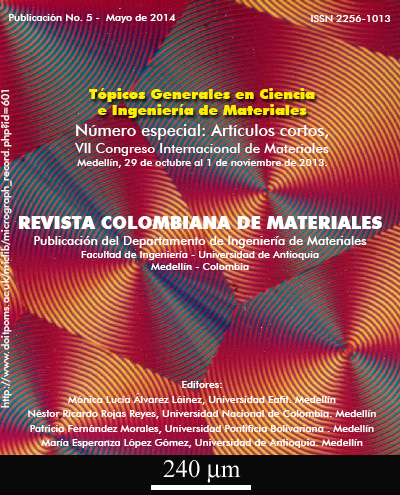ANÁLISIS MORFOLÓGICO DE LA POROSIDAD DE UN SISTEMA DE BARRERA TÉRMICA SOMETIDO A CARGAS TÉRMICAS CONSTANTES
DOI:
https://doi.org/10.17533/udea.rcm.19413Palabras clave:
Porosidad, Recubrimientos de barrera térmica, Análisis digital de imágenesResumen
El análisis microestructural de barreras térmicas PS-TBC (Plasma Spray – Thermal Barrier Coatings) es usado para determinar sus propiedades y estimar su vida útil en componentes de turbinas y otros dispositivos sometidos a alta temperatura. La porosidad es una característica microestructural de los sistemas TBC que evoluciona con la exposición a alta temperatura. En este trabajo se hace un seguimiento a la sinterización y cambios morfológicos de los poros en la capa TC (Top Coat) con relación al tiempo de exposición a 1100°C tanto en sostenimiento continuo como en ciclaje térmico. Los resultados de los ensayos isotérmicos y los ciclos térmicos se procesaron mediante análisis digital de imágenes.
Descargas
Citas
G. Evans, D. R. Mumm, J. W. Hutchinson, G. H. Meier, and F. S. Pettit, “Mechanisms controlling the durability of thermal barrier coatings,”
Progress in Materials Science,Vol. 46, No. 5, pp. 505–553, Jan. 2001. DOI: https://doi.org/10.1016/S0079-6425(00)00020-7
M. P. Boyce, Gas turbine engineering handbook. Access Online via Elsevier, 2012.
.H. J. Jang, D.-H. Park, Y.-G. Jung, J.-C. Jang, S.-C. Choi, and U. Paik, “Mechanical characterization and thermal behavior of HVOF-sprayed bond coat in thermal barrier coatings (TBCs),” Surface and Coatings Technology, Vol. 200, No. 14, pp. 4355–4362, 2006. DOI: https://doi.org/10.1016/j.surfcoat.2005.02.170
R. A. Miller, History of Thermal Barrier Coatings for Gas Turbine Engines. Glenn Research Center, Cleveland, OH, 2009.
N. P. Padture, M. Gell, and E. H. Jordan, “Thermal barrier coatings for gas-turbine engine applications,” Science, Vol. 296, No. 5566, pp. 280–284, 2002. DOI: https://doi.org/10.1126/science.1068609
Osorio Julián, Maya Deiby, Barrios Augusto C., Lopera Adrian, Jiménez Freddy, Meza Juan M., Hernández-Ortiz Juan P., Toro Alejandro, “Correlations between microstructure and mechanical properties of air plasma-sprayed thermal barrier coatings exposed to a high
temperature”; Journal of American Ceramic Society; Accepted Manuscript,2013.
X. C. Zhang, B. S. Xu, H. D. Wang, and Y. X. Wu, “Effects of oxide thickness, interlayer and interface asperity on residual stresses in thermal barrier coatings,” Materials & design, Vol. 27, No. 10, pp. 989–996, 2006. DOI: https://doi.org/10.1016/j.matdes.2005.02.008
W. R. Chen, R. Archer, X. Huang, and B. R. Marple, “TGO Growth and Crack Propagation in a Thermal Barrier Coating,” Journal of Thermal Spray Technology, Vol. 17, No. 5–6, pp. 858–864, 2008. DOI: https://doi.org/10.1007/s11666-008-9251-8
C. Funke, J. Mailand, B. Siebert, R. Vaben, and D. Stover, “Characterization of ZrO-7 wt.% YO thermal barrier coatings with different porosities and FEM analysis of stress redistribution during thermal cycling of TBCs,” Surface and Coatings Technology, Vol. 94–95, pp. 106–111, Oct. 1997. DOI: https://doi.org/10.1016/S0257-8972(97)00486-6
“ASTM international. Standard Guide for Metallographic Preparation of Thermal Sprayed Coatings, E 1920–03 (Reapproved 2008).”








